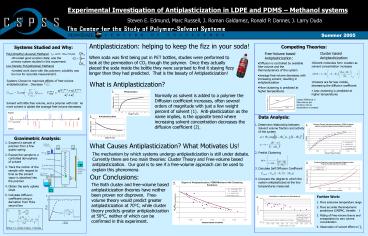Progress Report on LexanMethyl Salicylate Gravimetric Experiments - PowerPoint PPT Presentation
1 / 1
Title:
Progress Report on LexanMethyl Salicylate Gravimetric Experiments
Description:
Antiplasticization: helping to keep the fizz in your soda! When soda was first being put in PET bottles, studies were performed to look at ... – PowerPoint PPT presentation
Number of Views:38
Avg rating:3.0/5.0
Title: Progress Report on LexanMethyl Salicylate Gravimetric Experiments
1
Experimental Investigation of Antiplasticization
in LDPE and PDMS Methanol systems
Steven E. Edmund, Marc Russell, J. Roman
Galdamez, Ronald P. Danner, J. Larry Duda
Summer 2005
Antiplasticization helping to keep the fizz in
your soda!
Competing Theories
Systems Studied and Why
Cluster based Antiplasticization
Free-Volume based Antiplasticization
Poly(dimethyl siloxane)-Methanol Tg-123C
MW770,000
When soda was first being put in PET bottles,
studies were performed to look at the permeation
of CO2 though the polymer. Once they actually
placed the soda inside the bottle they were
surprised to find it staying fizzy longer then
they had predicted. That is the beauty of
Antiplasticization!
- Provided good sorption data was the primary
system studied in this experiment
- Solvent molecules form clusters as solvent
concentration increases - Clusters are far less mobile, decreasing the
diffusion coefficient - Less clustering is predicted at higher
temperatures
- Diffusion is controlled by available free-volume
and the thermodynamics of the system - average free-volume decreases with increasing
solvent, resulting in antiplasticization - More clustering is predicted at higher
temperatures
Low Density Poly(ethylene)-Methanol
- Limited work done with this polymer solubility
was too low for accurate measurement.
Systems Chosen to maximize effects of free-volume
antiplasticization. Decrease .
What is Antiplasticization?
1.
Normally as solvent is added to a polymer the
Diffusion coefficient increases, often several
orders of magnitude with just a few weight
percent of solvent (1). Anti-plasticization as
the name implies, is the opposite trend where
increasing solvent concentration decreases the
diffusion coefficient (2).
Larger difference in free-volume per jumping unit
as temperature increases
Solvent with little free volume, and a polymer
with lots! As more solvent is added the average
free-volume decreases
Data Analysis
2.
- Determine relationship between Solvent volume
fraction and activity of the system - Predict Clustering
- Calculate Self Diffusion Coefficient
- Compare the degree to which the system
antiplasticized at the two temperatures measured.
1.
Gravimetric Analysis
- Suspend a sample of polymer from a fine quartz
spring - Expose the sample to a controlled atmosphere of
solvent - Track the motion of the sample with respect to
time as the solvent vapor is absorbed into the
polymer - Obtain the early uptake slope
- Calculate Diffusion coefficient using a
derivation from Ficks second law
What Causes Antiplasticization? What Motivates Us!
The mechanism by which systems undergo
antiplasticization is still under debate.
Currently there are two main theories Cluster
Theory and Free-volume based antiplasticization.
Our goal is to see if a free-volume approach can
be used to explain this phenomena.
2.
Our Conclusions
4.
The Both cluster and free-volume based
antiplasticization theories have neither been
proven nor disproven. Free-volume theory would
predict greater antiplasticization at 70C, while
cluster theory predicts greater
antiplasticization at 50C, neither of which can
be confirmed in this experiment.
Further Work
3.
- More extensive temperature range
- More accurate thermodynamic predictions (UNIFAC,
Variable ) - Fitting of Free-volume theory and extrapolation
to zero solvent concentration - Observation of solvent effect on Tg
5.
Pressure decay data by Galdamez and Navarro
Where N number of sides L thickness








![Market Report on Global and China Forklift Industry [2015-2017] PowerPoint PPT Presentation](https://s3.amazonaws.com/images.powershow.com/8338547.th0.jpg?_=20151230044)






















